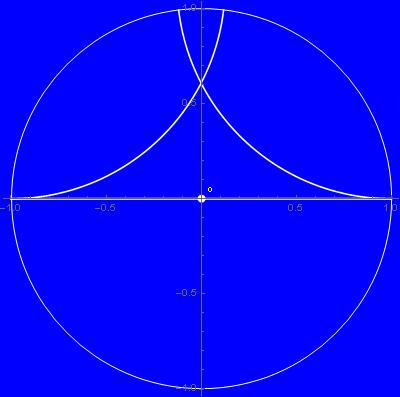In SU(1,1) straight lines on the disk we have seen nice families of parallel straight lines in the hyperbolic geometry of the unit disk of the complex plane. Here is one such family:

Let us recall how was it obtained. We start with a template straight line through the origin ![]() at
at ![]() .
.

Then we take one-parameter group of SU(1,1) transformations ![]() generated by
generated by ![]()
(1) ![]()
(2) ![]()
We apply transformations ![]() to our template straight line (we use fractional linear transformations explained in previous posts), for several different values of
to our template straight line (we use fractional linear transformations explained in previous posts), for several different values of ![]() , and we obtain the family depicted above.
, and we obtain the family depicted above.
Let us take a particular case, with ![]()
We have ![]()
![]() therefore the point
therefore the point ![]() on the template line is transformed into
on the template line is transformed into ![]() given by
given by
(3) ![]()
The whole template line is transformed as follows

We obtain another straight line, parallel to the original one (as the two lines do not intersect). If we rotate this new line clockwise about the origin, at a certain point the two lines touch at ![]() . That is the limit of being parallel. If we rotate further, then the two lines start to intersect.
. That is the limit of being parallel. If we rotate further, then the two lines start to intersect.
Let us calculate the angle ![]() that we need to use to reach the limit. We set
that we need to use to reach the limit. We set ![]() in Eq. (3) and solve for
in Eq. (3) and solve for ![]() such that
such that
(4) ![]()
Solving this I am finding (in radians)
(5) ![]()
Our U(1) rotation group is defined by matrices
(6) ![]()
It acts on complex numbers by:
(7) ![]()
Therefore in order to obtain the limiting line we need to apply ![]()
(8) ![]()
The total transformation ![]() that we will use is therefore
that we will use is therefore
(9) ![]()
Acting on the point ![]() on the real axis it produces a point
on the real axis it produces a point ![]() in the disk
in the disk
(10) ![]()
![]()
The real part, ![]() vanishes for
vanishes for ![]() The imaginary part has, for this
The imaginary part has, for this ![]() the value
the value ![]() . That means that at
. That means that at ![]() the limiting line crosses the vertical imaginary axis.
the limiting line crosses the vertical imaginary axis.

We could easily repeat the above reasoning applied, this time, to the left point ![]() We would get the second limiting line. The two lines cross at
We would get the second limiting line. The two lines cross at ![]() , as shown below:
, as shown below:

We will continue our adventure in the next post. We will produce there this image of parallel lines – the Angel of Geometry






Arku,
należy mi się wyjaśnienie jaka jest przyczyna tego, że w niniejszym poście wzór (2) wygląda jak wygląda.
Mam kilka hipotez.
1. Wzór ten edytowałeś dzisiaj od początku ze swojej biologicznej pamięci. (mało prawdopodobne)
2. Wzór ten edytowałeś dzisiaj od początku na podstawie swoich błędnych odręcznych notatek, których nie poprawiłeś. (mało prawdopodobne)
3. Wzór ten skopiowałeś dzisiaj z jakiś swoich niepublikowanych cyfrowych zasobów, w których nie naniosłeś poprawki. (uporczywe istnienie i powielanie błędu – podobnie jak z kodem DNA)
4. Niniejszy post dzisiaj opublikowany napisałeś wcześniej niż dwa dni temu.
2)
My answer was incomplete. Writing a post I have to compile latex formulas many-many times, to see if they are correct. I am often making latex errors. Writing online, each time I compile, an external latex server must be connected. So, first I write everything as a latex file and compile on my PC. So, for each post I have a a latex draft on PC. The draft is not always exactly the same as the post, since latex on PC would not compile with some tags that are being used by the blogging software.
“The draft is not always exactly the same as the post”
So it is rather version 3) not 2).
Taking care of databases consistency is a painful job, but necessary.
Yes, indeed. I am learning. Probably it would be useful to have all important and true formulas collected in one document, but there is not enough time to do that …
A może znajdą się też diabołki?
https://qph.ec.quoracdn.net/main-qimg-414c17164b15455a2604afe086bf0427-c
Should there be minus in exponent in (7) ?
(with consequences)
Thanks. Fixed.
So (8) should be Hermited.
Right. Done. Thanks.
Done but without heart.
Mea maxima culpa.